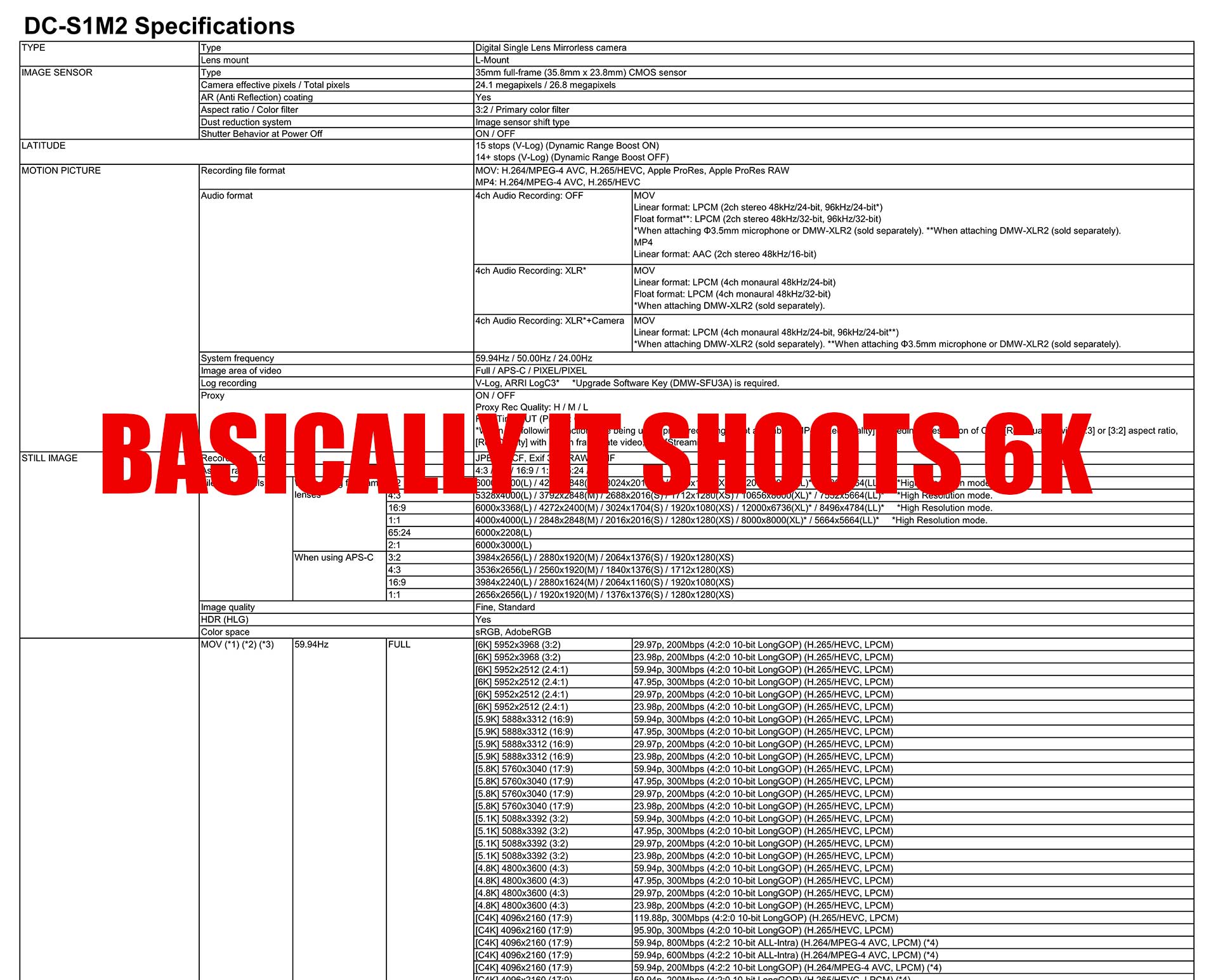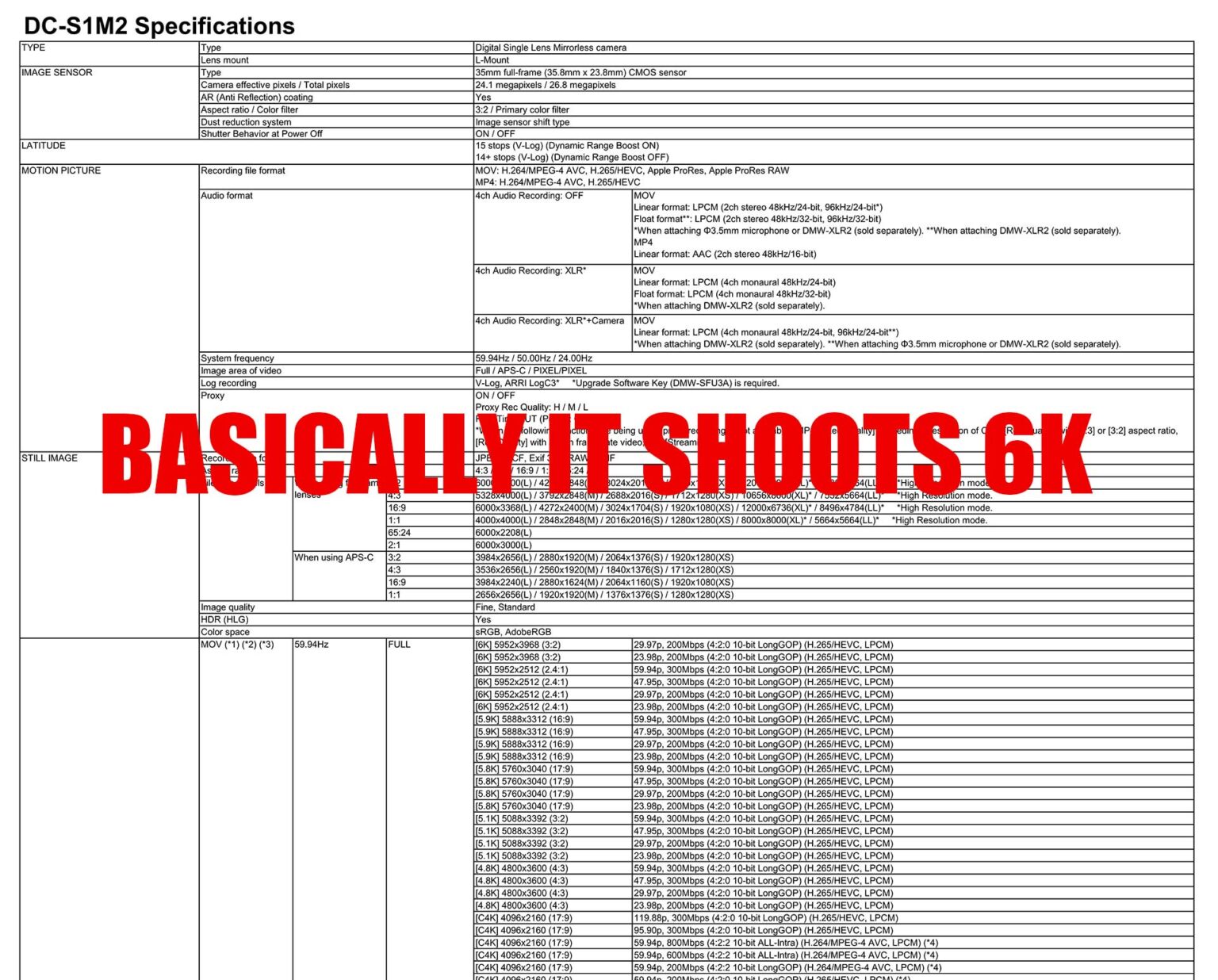
Now we get to set up our quantum computer to work out which codec is active in which crop mode.
Have you ever felt that you’re in the wrong body. The S1 II must feel it, being in the body of a low-to-mid range camera when it is actually the first proper sensor and spec upgrade Panasonic has made since the original S1 in 2018. We have waited 7 years for it.
The S1 II has a new 2025 sensor, with two dynamic range modes and open gate 6K/60p.
The S1 IIe has an older, slower sensor – likely the same as the S5 II, but will also do 6K/60p if you enable letterbox format in 2.4:1. The open gate 6K is capped to 30p.
The more expensive £3500 S1 II has a 4K/120p mode, pixel binned like the existing rival cameras from Canon, Sony and Nikon. It’s good to see this feature on the S1 II.
Again however the S1 IIe model lacks this, and 4K/60p also requires a 2.4:1 crop, with 16:9 and DCI 4K 16:9 format being capped at 30p.
Unfortunately both the cheaper and more expensive cameras feature exactly the same body, the same 5.76 million dot EVF with 120hz refresh rate, same autofocus system, Dual Native ISO (V-LOG) of 640/5000 on the S1 II, the mechanical shutter rate is the same at 10fps, the stabilisation is the same, it would have been nice to see a bit more differentiation in design and features between the S1 II vs the S1 IIe or indeed the “basic model” S5 II.
Apart from the new sensor, they are all a bit too similar for my liking.
It remains to be seen whether the new sensor, which is only a 24 megapixel design, partially stacked, makes it’s way into the S1H II and whether the S1H II will take the form of an S5 II as well, or changes to a body closer to the Sony FX3 shorn of an EVF. Neither option appeals to me, but if I had to choose I’d probably take the FX3-type design.
Now something that’s also mentioned in the leak is a 70fps electronic shutter, which should please the sports and wildlife photography crowd. That’s a good improvement over the S1 Mark IIe which is capped at 30fps with the old sensor.
S1 II headline video modes:
- Standard frame rates: 5.9K/60p 17:9, 5.1K/60p Open Gate, 4.8K/60p 4:3 Anamorphic Mode
- High frame rates: 4K/120 binned, 1080p/240.
- Crop modes: 3.3K 120p 4:3 (1:1 crop) and 4K/120p 16:9 and 17:9 (upscaled from 3.3K?) in APS-C mode
- The standard frame rates 60/50/30/25/24p are also available in crop mode.
S1 IIe headline video modes:
- Standard frame rates: 6K/30p Open Gate, 6K/60p 2.4:1 Letterbox Mode, 4K/60p 2.4:1
- High frame rates: 1080p/180fps, there’s no frame rate higher than 60p in the 3K,4K or 6K modes but there is a S&Q 4K 60p mode in 2.4:1 letterbox
- Crop modes: 3.3K 60p 4:3 (1:1 crop) and 4K/60p 16:9 and 17:9 (upscaled from 3.3K?) in APS-C mode
- The standard frame rates 60/50/30/25/24p are also available in crop mode.
The S1 II with the new sensor is interesting but the price is set too high, at £3500.
The most similar model I can think of is the Nikon Z6 III, but the S1 II has a broader range of video modes and frame rates. The 4K/120p for example is preferable on the S1 II as it doesn’t crop.
But beyond the same features we’ve been used to from Panasonic since the S5 II, there’s little to write about.
There’s no fully stacked sensor, or 8K, there’s no Panasonic RAW codec, only ProRes RAW, no built in eND or other innovations I’d like to see before I die.
There’s no longer a top panel LCD, which is a pity because the one on the S1H is the best there is, up there with the GFX 100 II. I know a top panel LCD isn’t top of the features list, but it’s a useful high-end touch that would have helped make the S1 II look at home along side other £3500 cameras like the Nikon Z8.
As I remarked in previous posts I think Panasonic have lost their spark of creativity and that uniqueness that helped them to stand out from other cameras that had locked most users into one of three leading mounts. For L-mount to win these users over we needed more, and we haven’t had it. The 7 year gap is deeply problematic, and I believe the company is heading for a troubled period where they will not have the level of R&D funds available to dig themselves out of a single figure market share in mirrorless cameras, having started the 2010s on double digits.
A lot more imagination and risk taking is required than Panasonic are giving us at the moment.



